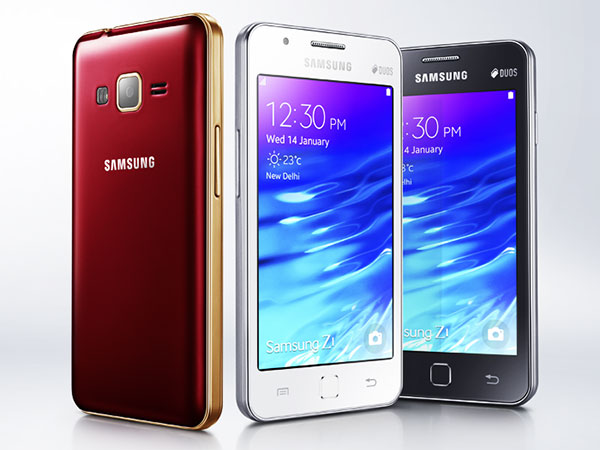Samsung on Wednesday released the first Tizen-powered smartphone for India, the Samsung Z1.
The Tizen phone offers localized entertainment apps and a simpler user interface than Android, the company said.
Tizen is an open source platform that Samsung has taken the lead in developing. It is an offshoot of the Linux OS.
Samsung announced a new line of Smart TVs powered by the Tizen operating system at last week’s CES 2015.
Tizen OS 2.3 enables faster boot time and quicker access to apps than other mobile OSes. It delivers enhanced Web performance with faster page-loading times and decreased data usage.
The Samsung Z1 has a 1,500 mAh battery that provides long-lasting performance. Users can expect seven hours of nonstop videos and eight hours of talk time in Ultra Power Saving Mode. This battery feature ensures uninterrupted connections even at minimal battery levels.
“The smartphone market in India is rapidly evolving, with many consumers using their device as their screen of choice for content including videos, television programs and video games, as well as a range of apps,” said Hyun Chil Hong, president and CEO of Samsung India Electronics.
Competitive Impact a Gamble
Just how important the Tizen operating system will be for Samsung is anyone’s guess. Overall, India is a safer and more likely profitable bet for the company than some other, more mature markets, according to Charles King, principal analyst at Pund-IT.
“Any time a major vendor makes a commitment like Samsung’s to Tizen, it invests literal and not so literal assets in the effort. I expect that Samsung has spent a significant amount of cash on Tizen, so it stands to suffer financially if Tizen fails. But more ephemeral issues like strategic vision are also at stake. If Tizen falters or fails completely, the public embarrassment could be more painful than any monetary losses,” King told LinuxInsider.
Debuting the first release of a Tizen-powered phone in the Indian market makes sense.
“The Indian market has shown incredible smartphone growth, and we believe migration from feature phones to smartphones will increase,” a Samsung spokesperson said in a statement provided to LinuxInsider by Ashley Wimberley.
“India’s mobile market is … open to new smartphone platforms that are open source, can provide unique local solutions, and are adaptable across multiple brands,” the spokesperson noted.
Samsung also plans to provide support to develop strong software competency and engineering resources for India’s Tizen ecosystem.
Conventional wisdom suggests that the Indian market is in an early evolutionary state. That makes it more amenable to new offerings like Tizen-based devices, noted King.
“Though products in India tend to be cheaper than those in more developed markets, the sheer number of Indian consumers can drive considerable sales volumes,” he said.
Platform Highlights
The Samsung Z1’s user interface is powered by a 1.2-GHz dual-core processor and comes with 768 MB RAM and 4 GB internal storage, expandable to 64 GB with a microSD card. The device has dual SIM support and a 4-inch WVGA PLS (Predictive Leadership Solutions) screen.
The smartphone is equipped with a 3.1-megapixel rear camera that allows high-quality shots in low light settings, and a VGA front camera with an auto face detect feature to easily capture more natural selfies. The device measures 120.4 x 63.2 x 9.7 mm and weighs 112g. Samsung’s Z1 Tizen phone is available in India in white, black and wine red.
The Samsung Z1 is equipped with features for quickly contacting emergency help. The SOS Alert feature, which is activated by pressing the power button four times, sends a Help message to the user’s primary contacts and then tracks the user’s location to provide necessary assistance.
Another novel feature is the built-in antivirus protection. It automatically checks for any viruses when users install an app, check email or receive an SMS. It also checks text messages for virus, smishing, phishing and even pharming attacks. If something is detected, the antivirus system notifies users and allows them to delete the message without opening it.
For enhanced security measures, consumers also can utilize Samsung Z1’s private mode. This feature lets users create their own private storage space where pictures and files can be saved.
Other Design Traits
Samsung bundled a host of marketing promotions with its Tizen phone release, including several free or trial use entertainment packages. These cover a wide range of free entertainment content spanning across categories such as music, movies, videos, mobile TV and radio.
Samsung is launching Joy Box, a free entertainment package that gives users access to music, TV and movies. In addition, the Samsung Z1 will offer consumers free access to premium content available on Club Samsung. Users can stream and download from a catalog of more than 270,000 songs and watch 80-plus live TV channels.
Samsung partnered with Hungama.com to deliver a wider selection of music streaming and downloading. More than 2 million Bollywood and English songs can be accessed for free for a period of three months. Samsung also partnered with mobile Live TV service nexGTv and Box TV, bundled for three months.
The Z1 phone is available for 5,700 Indian rupees (US$92).
Unlikely Android Replacement
Initially, the Samsung-backed Tizen OS is not likely to pose much competition worldwide for Android, “but if Samsung can entice major developers to create Tizen-based versions of successful apps and products, it will go a long way to making their OS self-sustainable,” said King.
In the mobile OS market, Android is the primary player for those that want to avoid either Apple or Microsoft. The Android app ecosystem is too rich and diverse for Samsung to leave behind.
“Smartphone and tablet users would find it easier to abandon Samsung for other handset makers. If momentum around Tizen grows, the company may consider deploying it across its entire portfolio,” King suggested, “but that kind of momentum will take years to develop, if it ever does.”





















































